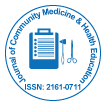Measuring the Impact of Community Nursing in Stroke Recovery
Received: 07-Mar-2025 / Manuscript No. jcmhe-25-167366 / Editor assigned: 10-Mar-2025 / PreQC No. jcmhe-25-167366 (PQ) / Reviewed: 24-Mar-2025 / QC No. jcmhe-25-167366 / Revised: 31-Mar-2025 / Manuscript No. jcmhe-25-167366 (R) / Published Date: 07-Apr-2025
Description
Stroke remains one of the leading causes of long-term disability worldwide, placing a significant burden not only on survivors but also on healthcare systems and caregivers. As advances in acute stroke care have led to improved survival rates, the importance of post-stroke rehabilitation has gained increasing recognition. In this context, community nursing plays a significant role in supporting stroke survivors through the rehabilitation process. However, while the significance of community nursing in stroke recovery is widely acknowledged, the effectiveness of these interventions demands structured and ongoing evaluation. Without robust evaluation frameworks, we risk underutilizing a crucial element of long-term stroke care.
Community nursing provides stroke survivors with continued, individualized care following discharge from acute hospital settings. This includes physical rehabilitation, medication management, patient education, psychosocial support and coordination with physiotherapists, occupational therapists and speech-language pathologists. Community nurses often serve as the first point of contact for patients and families navigating life after stroke, addressing not only clinical recovery but also emotional and social reintegration. Their role extends to fall prevention, lifestyle counseling and the identification of complications such as recurrent stroke, infections, or pressure injuries.
Evaluating the effectiveness of community nursing interventions is essential for multiple reasons. First, it provides evidence to justify investment in community-based rehabilitation programs. Second, it informs clinical best practices and helps identify which components of nursing care have the most impact on recovery outcomes. Third, effective evaluations can reveal disparities in service access and quality, prompting targeted policy reforms. Unfortunately, such evaluations are often limited by methodological challenges, fragmented data collection and a lack of standardized outcome measures.
One of the major obstacles in evaluating community nursing outcomes in stroke rehabilitation is the variability in patient needs and recovery trajectories. Stroke severity, location of brain injury, age, pre-existing comorbidities and social support structures all influence how a patient responds to nursing interventions. As a result, evaluations must account for this heterogeneity to accurately assess effectiveness. Rigid, one-size-fits-all outcome measures may fail to capture the nuanced improvements that matter most to stroke survivors such as improved mobility, independence in daily activities, or enhanced quality of life.
Another critical factor is the timing and duration of evaluations. Rehabilitation is an extended process, often requiring months or even years of support. Short-term assessments may capture early gains but miss long-term functional improvements or setbacks. Therefore, effective evaluations should adopt a longitudinal approach, tracking outcomes over a period sufficient to reflect the real impact of community nursing care. Integrating follow-up assessments at 3, 6 and 12 months post-discharge can provide a more accurate and comprehensive picture.
Patient-centered outcome measures are essential to these evaluations. Traditional metrics such as readmission rates or mortality, while important, may not fully reflect the patient’s experience or functional gains. Tools like the Modified Rankin Scale, Barthel Index and Stroke Impact Scale can provide valuable insight into changes in physical function, cognitive ability, emotional well-being and social participation. Importantly, incorporating qualitative feedback from patients and caregivers can enrich quantitative data and ensure that evaluations capture what truly matters to those receiving care.
In many healthcare systems, resource constraints limit the capacity to conduct in-depth evaluations. Community nurses are often overburdened and systematic documentation of outcomes may be deprioritized. To address this, digital health technologies provide potential solutions. Mobile health apps, telehealth platforms and electronic health records can facilitate real-time data collection, automate outcome tracking and enhance communication between care providers. These tools can also enable remote monitoring, which is particularly valuable in rural or underserved areas where access to rehabilitation centers is limited.
Interdisciplinary collaboration is also essential for effective evaluation. Community nurses do not operate in isolation; they are part of broader rehabilitation teams. Evaluations should therefore consider the integrated nature of care, assessing not only individual nursing interventions but also how nurses contribute to team-based goals and outcomes. Developing standardized protocols for collaborative documentation and reporting can help attribute outcomes more accurately and ensure that nurses’ contributions are recognized.
In conclusion, effective evaluations of community nursing in stroke rehabilitation are critical to optimizing patient recovery, guiding clinical practice and informing health policy. These evaluations must be comprehensive, patient-centered and context-sensitive. They should adopt both quantitative and qualitative methodologies, consider long-term outcomes and leverage technology to overcome logistical barriers. As the demand for post-stroke care continues to grow, community nurses will remain at the forefront of rehabilitation efforts. Ensuring their work is systematically evaluated and supported is not merely a matter of professional recognition—it is a necessity for delivering high-quality, equitable and sustainable stroke care.
Citation: Williams S. (2025) Measuring the Impact of Community Nursing in Stroke Recovery. J Community Med Health Educ 15:929.
Copyright: © 2025 Williams S. This is an open-access article distributed under the terms of the Creative Commons Attribution License, which permits restricted use, distribution, and reproduction in any medium, provided the original author and source are credited.
Select your language of interest to view the total content in your interested language
Share This Article
Recommended Journals
Open Access Journals
Article Usage
- Total views: 464
- [From(publication date): 0-0 - Dec 12, 2025]
- Breakdown by view type
- HTML page views: 376
- PDF downloads: 88
